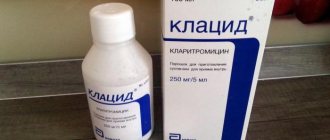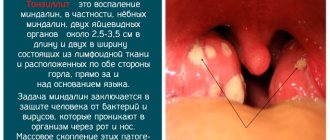Vilprafen is an effective antibacterial drug from the group of macrolides that helps cope with various infectious and inflammatory diseases of the body.
This product has a wide spectrum of antimicrobial action against many bacterial pathogens (staphylococci, streptococci, pneumococci, clostridia, etc.).
The main active ingredient is Josamycin, which exhibits pronounced antimicrobial properties in the fight against infection.
It is most effective for the complex treatment of infectious and inflammatory diseases of the upper and lower respiratory tract, inflammatory processes of the skin and soft tissues, as well as infections of the genitourinary system and gastrointestinal tract.
Main indications for use of Vilprafen:
- infectious and inflammatory processes of the respiratory system (tonsillitis, laryngitis, pharyngitis, acute or chronic bronchitis, pneumonia, tracheitis, laryngotracheitis, etc.);
- diseases of the skin and soft tissues (furunculosis, pyoderma, erysipelas);
- whooping cough;
- various injuries complicated by infection (burns, purulent wounds);
- diphtheria;
- otitis (inflammation of the middle ear);
- gonorrhea;
- acne (regular or spherical);
- syphilis;
- infectious diseases in dentistry (periodontitis, gingivitis);
- felon;
- sinusitis;
- infectious and inflammatory processes of the genitourinary system (urethritis, cystitis, prostatitis, pyelonephritis, etc.);
- lymphangitis;
- eye infections (blepharitis);
- scarlet fever.
Attention: before using this product, it is recommended to consult a physician!
Available in the form of soluble tablets and suspension for internal use.
pharmachologic effect
Antibiotic of the macrolide group. The mechanism of action is associated with disruption of protein synthesis in the microbial cell due to reversible binding to the 50S ribosomal subunit. In therapeutic concentrations, as a rule, it has a bacteriostatic effect, slowing down the growth and reproduction of bacteria. When high concentrations are created at the site of inflammation, it has a bactericidal effect.
Josamycin is active against gram-positive bacteria: Staphylococcus spp. (including methicillin-sensitive strains of Staphylococcus aureus), Streptococcus spp. (including Streptococcus pyogenes, Streptococcus pneumoniae), Corynebacterium diphtheriae, Listeria monocytogenes, Propionibacterium acnes, Bacillus anthracis, Clostridium spp., Peptococcus spp., Peptostreptococcus spp.; gram-negative bacteria: Neisseria meningitidis, Neisseria gonorrhoeae, Moraxella catarrhalis, Borde tella spp., Brucella spp., Legionella spp., Haemophilus ducreyi, Haemophilus influenzae, Helicobacter pylori, Campylobacter jejuni; susceptibility to Bacteroides fragilis may be variable; intracellular microorganisms: Chlamydia spp., in (including Chlamydia trachomatis), Chlamydophila spp. (including Chlamydophila pneumoniae, which was previously called Chlamydia pneumoniae), Mycoplasma spp. (including Mycoplasma pneumoniae, Mycoplasma hominis, Mycoplasma genitalium), Ureaplasma spp., Treponema pallidum, Borrelia burgdorferi.
As a rule, it is not active against enterobacteria, therefore it has little effect on the microflora of the gastrointestinal tract. Retains activity in case of resistance to erythromycin and other 14- and 15-membered macrolides. Resistance to josamycin is less common than to 14- and 15-membered macrolides.
In what cases is Vilprafen prescribed?
Vilprafen is prescribed for prostatitis, as it fights infection that destroys the prostate gland. It is also used for infectious diseases of the kidneys, bladder and inflammation of the urinary ducts.
Vilprafen successfully fights against staphylococcus, streptococcus, diphtheria bacillus, clostridia, chlamydia, ureaplasma, treponema and many other harmful and dangerous microorganisms. A course of treatment with Vilprafen is prescribed for infections transmitted through sexual contact. This means that it helps with tonsillitis, urethritis, pharyngitis, bronchitis or pneumonia.
Indications for use
Infectious and inflammatory diseases caused by microorganisms sensitive to the drug:
- infections of the upper respiratory tract and ENT organs (including tonsillitis, pharyngitis, paratonsillitis, laryngitis, otitis media, sinusitis);
- diphtheria (in addition to treatment with diphtheria antitoxin);
- scarlet fever (with hypersensitivity to penicillin);
- infections of the lower respiratory tract (including acute bronchitis, exacerbation of chronic bronchitis, community-acquired pneumonia, including those caused by atypical pathogens);
- whooping cough;
- psittacosis;
- infections in dentistry (including gingivitis, pericoronitis, periodontitis, alveolitis, alveolar abscess);
- infections in ophthalmology (including blepharitis, dacryocystitis);
- infections of the skin and soft tissues (including folliculitis, furuncle, furunculosis, abscess, anthrax, erysipelas, acne, lymphangitis, lymphadenitis, phlegmon, panaritium);
- wound (including postoperative) and burn infections;
- infections of the urinary tract and genital organs (including urethritis, cervicitis, epididymitis, prostatitis caused by chlamydia and/or mycoplasma);
- gonorrhea, syphilis (with hypersensitivity to penicillin), lymphogranuloma venereum;
- gastrointestinal diseases associated with Helicobacter pylori (including gastric and duodenal ulcers, chronic gastritis).
The essence of the problem
Prostatitis is a disease of the prostate gland. It can be caused by various reasons, but the most common is bacteriological damage to the prostate. Under the influence of pathogenic microorganisms, it swells, becomes inflamed and compresses the urethra passing through it. What causes difficulty and pain when urinating.
In addition, the prostate gland secretes a special secretion during ejaculation, making a man’s sperm viable, and the diseased organ cannot produce a sufficient amount of this substance, which leads to male infertility. Prostatitis can occur in middle-aged and older men and can be a consequence of a sedentary lifestyle or lack of regular sexual intercourse.
This disease also affects young men who live a polygamous sex life. It is this diversity that leads to inflammation of the prostate gland. After all, the bacteria that cause the disease are often transmitted through unprotected sex. Thus, prostatitis is a disease of men of any age.
When diagnosing prostatitis, special attention is paid to determining the type of bacteria that caused the pathology. This allows you to prescribe exactly the drug that will have a healing effect on the organ. Vilprafen is a remedy that can act not on one type of bacteria, but on a whole range of them.
Directions for use and doses
The recommended daily dose for adults and adolescents over 14 years of age is 1 to 2 g in 2-3 divided doses, the standard dose is 500 mg 3 times a day. If necessary, the dose can be increased to 3 g/day.
Typically, the duration of treatment, determined by the doctor, ranges from 5 to 21 days, depending on the nature and severity of the infection. In accordance with WHO recommendations on the use of antibiotics, the duration of treatment for streptococcal tonsillitis should be at least 10 days.
In anti-Helicobacter therapy regimens, josamycin is prescribed at a dose of 1 g 2 times / day for 7-14 days in combination with other drugs in their standard dosages (famotidine 40 mg / day or ranitidine 150 mg 2 times / day + josamycin 1 g 2 times / day daily + metronidazole 500 mg 2 times/day; omeprazole 20 mg (or lansoprazole 30 mg, or pantoprazole 40 mg, or esomeprazole 20 mg, or rabeprazole 20 mg) 2 times/day + amoxicillin 1 g 2 times/day + josamycin 1 g 2 times/day; omeprazole 20 mg (or lansoprazole 30 mg, or pantoprazole 40 mg, or esomeprazole 20 mg, or rabeprazole 20 mg) 2 times/day + amoxicillin 1 g 2 times/day + josamycin 1 g 2 times/day + bismuth tripotassium dicitrate 240 mg 2 times/day; famotidine 40 mg/day + furazolidone 100 mg 2 times/day + josamycin 1 g 2 times/day + bismuth tripotassium dicitrate 240 mg 2 times/day).
In the presence of atrophy of the gastric mucosa with achlorhydria, confirmed by pH-metry: amoxicillin 1 g 2 times / day + josamycin 1 g 2 times / day + tripotassium bismuth dicitrate 240 mg 2 times / day.
For ordinary and globular acne, 500 mg 2 times a day is prescribed for the first 2-4 weeks, then 500 mg 1 time a day as maintenance therapy for 8 weeks.
How does Vilprafen work?
Vilprafen begins absorption from the very first minutes after contact with the mucous membrane of the gastrointestinal tract. The concentration of the substance required for treatment in the body occurs 2-3 days after starting to take the drug.
Vilprafen for prostatitis
The substance is concentrated in the tonsils, skin, bone marrow, as well as in the kidneys and bladder. In the blood, the concentration of the substance is observed in monocytes and microphages.
If a woman takes the drug, then she should know that Vilprafen is able to penetrate the placenta during pregnancy, accumulate in the mammary glands and leave the body with milk. Vilprafen is excreted from the body in urine and bile. Moreover, urine transports only 20% of the substance.
special instructions
In the case of persistent severe diarrhea, one should keep in mind the possibility of developing life-threatening pseudomembranous colitis while taking josamycin.
In patients with renal failure, treatment should be carried out taking into account the results of appropriate laboratory tests (determination of endogenous creatinine clearance).
The possibility of cross-resistance to various macrolide antibiotics should be taken into account (microorganisms resistant to treatment with antibiotics related in chemical structure may also be resistant to josamycin).
Wilprafen®
The use of the following drugs in combination with josamycin is contraindicated due to the potential for serious side effects:
— Ergotamine, dihydroergotamine
The result of the interaction is the risk of severe vasoconstriction (ergotism) with the possible development of limb necrosis (due to inhibition of hepatic metabolism and elimination of ergot alkaloids).
— Cisapride, pimozide
As a result of the interaction, the risk of developing life-threatening arrhythmias, including ventricular tachycardia of the “pirouette” type, increases.
— Ivabradin
As a result of the interaction, the plasma concentration of ivabradine and associated side effects increase (due to inhibition of the hepatic metabolism of ivabradine).
— Colchicine
The interaction results in an increased risk of colchicine side effects, including potentially fatal ones.
The use of the following drugs in combination with josamycin is not recommended:
— Ebastine
Increased risk of life-threatening arrhythmias in patients with congenital long QT syndrome.
— Dopamine receptor agonists (bromocriptine, cabergoline, lisuride, pergolide)
An increase in the concentration of dopamine receptor agonists in the blood plasma with a potential increase in their activity and the appearance of overdose symptoms.
— Triazolam
Several cases of increased side effects of triazolam (conduct disorder).
— Halofantrine
Increased risk of ventricular arrhythmias, including ventricular tachycardia of the “torsades de pointes” type. If possible, josamycin should be discontinued. If it is not possible to cancel concomitant use of drugs, monitoring of the QT interval and ECG is necessary.
— Disopyramide
Increased risk of side effects of disopyramide: severe hypoglycemia, increased duration of the QT interval and life-threatening arrhythmias, including ventricular tachycardia of the “pirouette” type. Monitoring of clinical and laboratory data, as well as regular ECG monitoring, is necessary.
— Tacrolimus
Increased plasma concentrations of tacrolimus and creatinine as a result of inhibition of tacrolimus metabolism in the liver.
— Terfenadine and astemizole
During combined use of josamycin and antihistamines containing terfenadine or astemizole, the risk of developing life-threatening arrhythmias may be increased.
The use of the following drugs together with josamycin requires caution:
— Carbamazepine
It is possible to increase the concentration of carbamazepine in the blood plasma and develop overdose symptoms due to inhibition of its hepatic metabolism. It is recommended to monitor the patient's condition and the concentration of carbamazepine in the blood plasma. A dose reduction of carbamazepine may be required.
— Cyclosporine
Co-administration of josamycin and cyclosporine may cause an increase in plasma levels of cyclosporine and creatinine and increase the risk of nephrotoxicity. Plasma concentrations of cyclosporine and renal function should be regularly monitored. The dose of cyclosporine should be adjusted during co-administration with josamycin, as well as after discontinuation of josamycin.
— Indirect anticoagulants
It is possible to enhance the effect of indirect anticoagulants and increase the risk of bleeding.
Frequent monitoring of the international normalized ratio (INR) is necessary. It may be necessary to reduce the dose of indirect anticoagulants during co-administration with josamycin, and also in some cases after discontinuation of josamycin.
— Sildenafil
It is possible to increase the concentration of sildenafil in the blood plasma, increasing the risk of arterial hypotension. If co-administration is necessary, it is recommended to take the lowest dose of sildenafil.
— Theophylline and aminophylline
Caution should be exercised when using josamycin together with theophylline or aminophylline, because there is a risk of increased plasma theophylline concentrations, especially in children.
— Digoxin
When administered together, josamycin and digoxin may increase the level of the latter in the blood plasma.
— Other antibacterial drugs
Since bacteriostatic antibiotics in
vitro
may reduce the antimicrobial effect of bactericidal antibiotics, their simultaneous use should be avoided. Josamycin should not be used simultaneously with lincosamides due to a possible mutual decrease in effectiveness.
Amoxiclav
Amoxiclav is a semi-synthetic combination drug from the penicillin group, consisting of amoxicillin and an inhibitor of beta-lactamase (bacterial cell enzyme) - clavulonate. Available in tablets (250/125, 500/125, 875/125 mg), powder for dilution and parenteral administration (500/100, 1000/200 mg), powder for suspension (treatment in pediatrics).
The mechanism of action of amoxiclav is based on disruption of the synthesis of peptidoglycan, one of the structural components of the bacterial cell wall. This function is performed by amoxicillin. The potassium salt of clavulanic acid indirectly enhances the effect of amoxicillin by destroying some beta-lactamases, which typically cause bacterial resistance to antibiotics.
Indications for use of the drug:
- treatment of uncomplicated forms of inflammation of the renal collecting system and urinary tract;
- acute and chronic pyelonephritis in pregnant women (after assessing the risks of impact on the fetus).
How is Vilprafen used?
The regimen and dosage are prescribed by the doctor, based on the results of diagnosis of the disease, the severity of prostatitis and its nature. That is, both the dosage and the regimen are prescribed purely individually.
The drug should be taken after meals at the same time. This will make the concentration of active substances in the body maximum. The tablet must be swallowed whole. It cannot be ground into powder or broken into small fractions. Take the tablets only with water. If for some reason you cannot swallow the tablet, you can dissolve it in cold water and drink it. If the schedule for taking the drug is violated for more than 8 hours, you need to take 2 tablets at once at the next dose.
The minimum course of treatment with Vilprafen is 15 days. After this, the patient is sent for a second examination to the doctor, who then makes a conclusion about whether to continue therapy or not.








